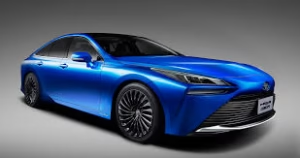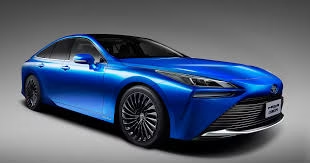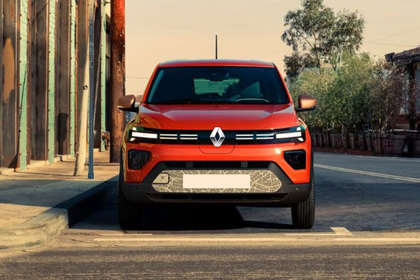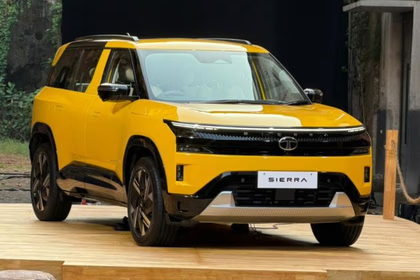Introduction
The Toyota Mirai is a visionary step into the future of clean mobility — an innovative hydrogen fuel cell electric vehicle (FCEV) that redefines the driving experience for a cleaner world. While conventional battery electric vehicles (BEVs) rely on battery packs, the Toyota Mirai drives with compressed hydrogen to produce electricity on the move, releasing only clean water vapour. As the world moves beyond fossil fuels, hydrogen fuel cell cars, such as the Toyota Mirai, provide an exciting solution for extended-range driving, super-fast refuelling, and zero-emission mobility. With Toyota’s legacy of trusted innovation — from Prius to hybrid dominance — the Mirai is the next great chapter in green driving. It doesn’t merely fit into the EV universe — it broadens it.

- Toyota Mirai is an FCEV, not a battery EV.
- Makes electricity on board from compressed hydrogen and oxygen with zero tailpipe emissions (only water).
- Provides a strong competitor to BEVs, particularly where range anxiety and lengthy charging times are concerns.
- Well-suited for long-distance drivers and fleet use, due to rapid refuelling (~5 mins) and 600+ km range.
- Complements battery EVs by diversifying clean mobility options and reducing grid dependency.
- Demonstrates Toyota’s long-term vision towards sustainable innovation in mobility.
1. Zero Emissions, Maximum Impact
The Toyota Mirai isn’t just eco-friendly — it’s radically clean. Powered by hydrogen, the Mirai’s fuel cell generates electricity with the byproduct being water vapor. That means no CO₂, no nitrogen oxides, and no particulate pollution — just clean, invisible steam. However, Mirai’s environmental impact extends even further. In comparison to traditional ICE cars and even some battery electric vehicles (BEVs), the Mirai is capable of having lower lifecycle total emissions, particularly when fueled with green hydrogen derived from renewable sources such as the sun or wind. It’s not merely zero-emission at the tailpipe — it’s designed for a low-carbon future from the ground up.
- The Toyota Mirai releases nothing but water vapour — no CO₂, no toxic gases.
- It employs a fuel cell to split hydrogen and oxygen into electricity while driving.
- No burning equals zero particulate matter, NOx, or carbon monoxide.
- Has cleaner lifecycle emissions than ICEs and even certain BEVs, particularly when hydrogen is made sustainably.
- Tailpipe emissions = zero pollution, perfect for clean cities and eco-conscious buyers.
2. Long Range That Rivals Petrol Cars
The Toyota Mirai offers an extraordinary range, capable of running up to 650 to 700 kilometres on a single hydrogen refill. Therefore, it is one of the very few zero-emission vehicles that can rival or outperform most ICE vehicles in reality. This is in contrast to most battery electric vehicles (BEVs), which have a range of 300–500 km — and frequently much less when using air conditioning, driving on highways, or carrying heavier loads — that can lose their full range due to slight variations in conditions. It is thus well-suited for long-commuting commuters, highway drivers, or fleet operators who require a steady, reliable range without sacrificing environmental friendliness. The Mirai is evidence that green need not necessarily equal short.
- Range: The Toyota Mirai offers a range of 650–700 km on a single hydrogen fill.
- Comparable or better than most petrol/diesel vehicles in actual range.
- Better than most BEVs that offer 300–500 km of range.
- Delivers the same range even with highway or AC-intensive usage.
- Best for customers needing long-range, zero-emissions driving without charging downtime.
3. Refuels in Just 5 Minutes
The Toyota Mirai is known for its rapid refuelling process — approximately 5 minutes to charge a full hydrogen tank. This process is virtually indistinguishable from refuelling a diesel or petrol vehicle and is exceptionally convenient and familiar. When compared to most battery electric vehicles (BEVs), which take anywhere from 30 minutes to several hours to charge, depending on the type of charger used, this is an invaluable benefit. This rapid refuelling makes the Mirai particularly appealing to fleet operators, ride-hailing companies, and long-distance commuters, where vehicle availability directly translates into efficiency and revenue. For drivers continually on the go, the Toyata Mirai represents the best of both worlds — zero emissions without a waiting game.
- Hydrogen refuelling takes 5 minutes, the same amount of time as petrol/diesel refuelling.
- Much quicker than the majority of BEV charging times (30 minutes to a few hours).
- Maintains low vehicle downtime, ideal for commercial and fleet applications.
- Perfect for road trippers, intercity travellers, and time-conscious drivers.
- Provides convenience + clean mobility, removing “range + recharge anxiety.”
4. Futuristic Design & Lexus-Level Comfort
The Toyota Mirai is not only an engineering marvel — it’s also a sight and a delight to experience. With its coupe-like, swept-back profile, fluid curves, and prominent front grille, the Mirai appears more like a concept car from the future than a zero-emission sedan. Its every contour is sculpted for aerodynamic performance, imbuing it with a confident, contemporary presence on the road. Step in, and you’re welcomed by a cabin that competes with a Lexus for comfort and sophistication — soft materials, ambient lighting, a floating infotainment screen, and a hushed drive. The Mirai is not only environmentally friendly; it’s a luxury experience with a conscience that demonstrates sustainability doesn’t equate to the expense of style or sophistication.
- Comes with a clean, aerodynamic design with bold styling language.
- Coupe-like profile and futuristic design stand out on the road.
- Interior offers luxury sedan-level comfort, inspired by Lexus design.
- Includes premium materials, advanced infotainment, and serene cabin acoustics.
- Blends cutting-edge tech with high-end styling, appealing to eco-luxury buyers.
5. Toyota’s Reliability & Global Leadership
As far as alternative fuel technology goes, no one is a more world leader than Toyota — and the Mirai is a perfect shining example of the company’s decades-long dedication to innovation.
Through the refinement of hybrid-electric systems over decades, Toyota has earned a reputation for engineering prowess and unparalleled reliability. The next-generation Mirai continues this legacy in ways that are even more impressive, with increased range, greater efficiency, a more sophisticated design, and richer integration of technology. Supported by an expanding footprint across the globe — from Japan and the United States to specific European and pilot Indian markets — Mirai is no test run. It’s a road-tested, world-proven innovation crafted by one of the world’s most reliable automotive brands.
- Toyota has over four decades of experience in hybrid and alternative fuel technology, beginning with the Prius.
- The second-generation Mirai features significant improvements, including increased range, enhanced performance, and refined design.
- Toyota’s worldwide rollout plan encompasses Japan, the U.S., Europe, and India (in a pilot phase).
- Recognised for reliability, durability, and safety, positioning Mirai as a reliable clean mobility option.
- Represents Toyota’s stewardship of hydrogen and future EVs.
6. Hydrogen Infrastructure Is Growing
The success of cars like the Toyota Mirai relies not only on the vehicle itself, but also on the world around it. And worldwide, that world is forming fast. Nations such as Japan, Germany, South Korea, and the U.S. (particularly California) are committing billions to creating hydrogen refuelling stations, green hydrogen production, and policy incentives.
Even India has embarked upon its National Green Hydrogen Mission to develop an end-to-end H2 supply chain. Toyota is not waiting in the wings — it’s busily collaborating with government agencies, energy providers, and infrastructure developers to construct this network. Whether it’s working with Shell, Air Liquide, or Indian Oil, Toyota is ensuring that the Mirai and hydrogen mobility have the infrastructure to go global.
- Japan, EU countries, California, and India are investing in hydrogen infrastructure.
- Green hydrogen production, tax credits, and public-private partnerships are government initiatives.
- India’s Green Hydrogen Mission aims to establish a framework for the installation of hydrogen production, storage, and distribution infrastructure.
- Toyota collaborates with fuel providers and technology companies to expand refuelling networks (e.g., Shell, Air Liquide, IOCL).
- Mirai takes advantage of Toyota’s role in developing ecosystems, not only vehicle innovation.
7. Future-Proof Investment for Clean Mobility
The Toyota is designed for such a future — one in which cars have no carbon footprint, roads facilitate quick refuelling, and energy is finally renewable. By going for the Mirai, motorists aren’t merely early adopters — they’re pioneers of a new age of clean mobility. It’s an investment for the future that honours both ecological consciousness and technological advancements.
- The Mirai aligns with the vision of a zero-emission, hydrogen-fueled future.
- Built to be compatible with green hydrogen manufactured through renewable energy.
- Owners join a worldwide clean-tech movement, not merely a car purchase.
- Indicates a shift to long-term, sustainable transport, moving beyond reliance on lithium batteries.
- Future-proofed for eco-regulations, fuel autonomy, and climate objectives.
Toyota Mirai vs Other Zero-Emission Vehicles (2025)
| Feature / Model | Toyota Mirai (FCEV) | Hyundai Nexo (FCEV) | Tesla Model S (BEV) | Tata Nexon EV Max (BEV, India) |
| Powertrain Type | Hydrogen Fuel Cell (FCEV) | Hydrogen Fuel Cell (FCEV) | Battery Electric Vehicle (BEV) | Battery Electric Vehicle (BEV) |
| Range (Claimed) | 650–700 km | ~610 km | ~650–700 km (Long Range) | ~453 km |
| Refueling / Charging Time | ~5 minutes (H₂ refill) | ~5 minutes | 30–60 mins (fast charge) | 56 mins (0–80%, DC fast) |
| Emissions | Zero (only water vapor) | Zero (only water vapor) | Zero tailpipe emissions | Zero tailpipe emissions |
| Fuel Availability | Limited (growing globally) | Very limited | Widely available chargers | Growing fast in India |
| Price (Approx.) | ₹1.2 Cr (pilot/demo) | ₹1.1 Cr (not in India) | ₹1.2 Cr+ (India import) | ₹19–20 lakh (ex-showroom) |
| Refueling Infrastructure | Expanding (Japan, CA, EU, India-pilot) | Limited | Strong (global EV charging) | Expanding fast across India |
| Ideal For | Long-range, fast-turn use, fleets | Similar use case | Luxury BEV users | City & intercity commuters |
Final Thoughts
The Toyota Mirai is not only the next step in car innovation — it’s a giant leap toward a cleaner, brighter, and more sustainable future. Its zero-emissions capability, extensive range, lightning-fast fill-up, and premium quality come together to show that hydrogen fuel cell technology is no longer a dream — it’s ready for the drive. Supported by Toyota’s legendary dependability and an expanding global hydrogen infrastructure.
The Mirai is a pioneering solution to the climate crisis of our era. As governments, businesses, and consumers shift their focus away from fossil fuels, hydrogen is rapidly emerging as the new frontier in the mobility sector. So the question remains: Is India prepared for the hydrogen revolution? Can the Toyota Mirai be your next clean car?
FAQs
Q1. How much does the Toyota Mirai cost?
The Toyota Mirai costs approximately ₹1.2 crore in India (for the pilot launch), while globally in countries such as the U.S., it begins at around $50,000.
Q2. How far can the Toyota Mirai travel on a full tank of hydrogen?
The new-gen Toyota Mirai has a range of up to 650–700 km on a full tank of hydrogen after a refill.
Q3. How long does the refuelling of the Toyota Mirai take?
Refuelling takes about 5 minutes, like a petrol or diesel car.
Q4. Does the Toyota Mirai produce any pollution?
No. The Toyota Mirai is a zero-emissions car that produces only water vapour out of its tailpipe.
Q5. Is hydrogen fuel safe for use in cars?
Yes. Hydrogen is carried in highly reinforced carbon-fibre fuel tanks with enhanced safety features. Toyota rigorously tested the Mirai for safety in crashes and leakage protection.
Q6. Is the Toyota Mirai sold to the general public in India?
The Toyota Mirai is currently sold in pilot and demo phases in India in association with IOCL. A total commercial launch is contingent upon the preparedness of the hydrogen infrastructure.
Q7. Is the maximum speed and performance of the Mirai?
The Toyota Mirai has a top speed of approximately 175 km/h and provides silky, almost silent acceleration with 182 hp electric power.
Q8. Can I produce hydrogen in my home or charge it like an EV?
No. Hydrogen must be refilled at special hydrogen refuelling stations, not charged like a battery EV.





